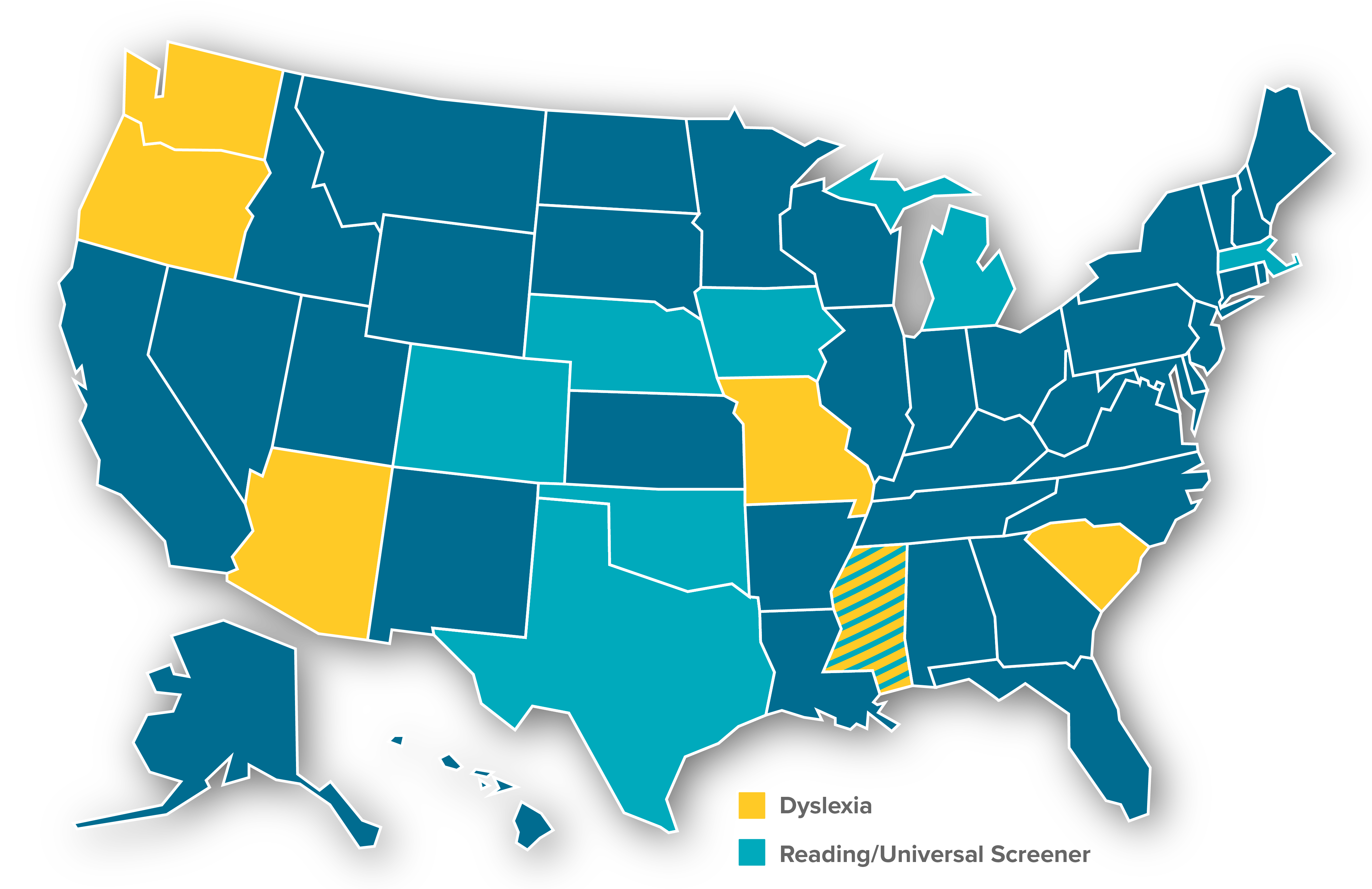Across the country, legislation related to dyslexia is being proposed at an extremely fast pace, which means the need for accurate dyslexia screening is top of mind for most educators. Between January and March of 2018, 33 laws related to dyslexia were introduced in the United States (Youman and Mather, 2018). This is, at least partially, in response to continued concern related to lack of early, intensive interventions for students who enter school with potential reading problems. When schools are using FAST earlyReading™ to identify class and student learning needs, many of the requirements of state dyslexia laws are met. These laws provide an opportunity for schools to highlight the early screening and intervention work they’re doing while continuing to improve their data-driven practices.
Educators are so busy that having and resources that meet multiple needs, including dyslexia screening, are essential! When screening with earlyReading, FastBridge reports may support the requirements put forth in state dyslexia laws, as well as provide teachers with information about individual student and small group needs for all students. Dyslexia is a term used to refer to unexpected difficulties in learning to read. The International Dyslexia Association (IDA) provides the following definition (2018):
“Dyslexia is a specific learning disability that is neurobiological in origin. It is characterized by difficulties with accurate and/or fluent word recognition and by poor spelling and decoding abilities. These difficulties typically result from a deficit in the phonological component of language that is often unexpected in relation to other cognitive abilities and the provision of effective classroom instruction. Secondary consequences may include problems in reading comprehension and reduced reading experience that can impede growth of vocabulary and background knowledge.”
Given that reading skills are essential for later success in school and life, FastBridge Learning® offers a number of reading assessments that can be used to screen and progress monitor reading difficulties.
Screening and Progress Monitoring Reading Difficulties
The FastBridge earlyReading assessment can be used for both screening and progress monitoring. The screening version is known as the Composite and can be used with students in kindergarten and first grade to support early identification and intervention for dyslexia. It is comprised of four assessments at each screening time period (fall, winter and spring). The assessments in the Composite change as the year progresses, with at least one assessment being the same throughout the year. For instance, Concepts of Print is used only in the fall of kindergarten, because it is a great indicator of previous exposure to literacy activities, but is no longer predictive by the middle of kindergarten because the vast majority of students have mastered those tasks by that time. Therefore, it’s in the fall Composite for kindergarten, but not in subsequent composites. The subtest Letter Sounds is included in the kindergarten Composite for fall, winter, and spring because this skill shows continuous growth during kindergarten. Once administered, the scores from earlyReading can be used in multiple ways to support students at risk in early reading skills.
When implementing FAST earlyReading for dyslexia screening, teachers and teams will do 3 things:
- Assess to identify students at risk;
- Address student needs through small group instruction and intervention for those who need it; and
- Monitor student learning through progress monitoring.
Assess Early Literacy Skills
First, teachers will assess by listening to each of their children demonstrate essential early literacy skills through the Composite screening assessment. When teachers listen to students engage in the screening tasks, they get a sense of what accurate and automatic skills sound like.
Address Student Needs
After dyslexia screening, grade level teams meet to review screening reports (like the Detailed Group Report) to identify instructional groups and determine how to best address student needs. Methods for addressing students’ needs include small groups in classrooms, as well as supplemental intervention groups for those students who are below benchmark targets. These early intervention practices are essential for keeping small skill deficits from becoming large achievement gaps. The Detailed Group Report can be used to first identify those students who are at-risk for dyslexia, or other reading difficulties. This report can be sorted to focus on the students most at-risk. In the following fictional class, 9 students are below expectations in the fall of Kindergarten.
The same report can then be used to determine intervention instructional matches to best target intervention to specific student needs. In this case, it looks like 7 students scored in the risk zone on Onset Sounds which is a measure of Phonemic Awareness (PA). Given the importance of this literacy skill, we should begin this intervention as soon as possible.

Monitoring Student Progress
Last, when students are receiving the intervention, schools are putting additional resources toward improving critical early literacy skills. In these cases, teachers should monitor student progress with regular progress monitoring assessments. FASTT has nine measures in earlyReading that can be used to monitor student progress toward reading goals. It is recommended to use earlyReading progress monitoring measures weekly with students receiving the intervention. These data can then be reviewed in between screening time periods to identify when intervention can be ended or needs to be intensified.
Educators are working every day to support student learning needs. When faced with meeting requirements of a dyslexia law, we can react in two ways. We can treat screening as something we do for legislators and set the data aside after meeting the legal requirements. Or, we can use this opportunity to leverage the laws to promote and improve our practices in early screening and intervention for reading difficulties. In addition, we can show our communities that we’ve implemented FAST to support early dyslexia screening and intervention across content areas and grades. Through early screening with FAST reading assessments such as earlyReading, we can implement a process where we continually assess and address all students’ learning needs.
References
International Dyslexia Association. (2018). Definition of dyslexia. Retrieved from: https://dyslexiaida.org/definition-of-dyslexia/.
Youman, M. & Mather, N. (2018). Dyslexia laws in the USA: A 2018 update. Perspectives on Language and Literacy, Spring, 37-41.


![[eBook] Get the Whole Picture: Using Social, Emotional and Behavioral Assessments to Support Student Success](https://5196620.fs1.hubspotusercontent-na1.net/hubfs/5196620/AdobeStock_157265506.jpeg)





